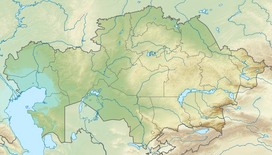Kazakh Uplands
| Kazakh Uplands | |
|---|---|
| Сарыарқа / Казахский мелкосопочник | |
 Landscape of the Karkaraly Range, one of the ranges of the uplands | |
| Highest point | |
| Peak | Aksoran |
| Elevation | 1,565 m (5,135 ft) |
| Coordinates | 48°25′26″N 75°28′16″E / 48.42389°N 75.47111°E |
| Dimensions | |
| Length | 1,200 km (750 mi) E / W |
| Width | 400 km (250 mi) N/ S |
| Geography | |
Location in Kazakhstan | |
| Location | Palearctic |
| Biome | Temperate grasslands, savannas, and shrublands |
| Geography | |
| Area | 72,000 km2 (28,000 sq mi) |
| Country | Kazakhstan |
The Kazakh Uplands (Kazakh: Сарыарқа, Saryarqa - "Yellow Ridge", Russian: Казахский мелкосопочник, Kazakhskiy Melkosopochnik), also known as the Kazakh Hummocks, is a large peneplain formation extending throughout the central and eastern regions of Kazakhstan.[1]
Administratively the Kazakh Uplands stretch across the East Kazakhstan, Pavlodar, Akmola, Ulytau and Karaganda regions. Several notable cities, including the country's capital, Astana, are located in the uplands. There are large deposits of coal in the north and copper in the south.
Geography
The Kazakh Uplands are limited by the
Rivers such as the
Subranges
The uplands include mountain ranges of moderate altitude separated by elevated flat
The main ones are:- Kyzylarai, highest point Aksoran, 1,565 metres (5,135 ft)
- Karkaraly Range, highest point Zhirensakal, 1,403 metres (4,603 ft)
- Kokshetau Hills, a subrange of the uplands
- Kokshetau Massif, highest point Mount Kokshe, 947 metres (3,107 ft)
- Kent Range, highest point Mount Kent, 1,469 metres (4,820 ft)
- Bayanaul Range, highest point Akbet, 1,022 metres (3,353 ft)
- Ulutau, highest point Akmeshit, 1,131 metres (3,711 ft)
- Kyzyltas, highest point Kushoky, 1,283 metres (4,209 ft)
- Degelen, highest point 1,084 metres (3,556 ft)
- Chingiztau, highest point Kosoba, 1,304 metres (4,278 ft)
- Bektauata, highest point 1,213 metres (3,980 ft)
- Mount Ku, highest point 1,356 metres (4,449 ft)
- Bakty Range, highest point Mount Aktau 1,176 metres (3,858 ft)
- Myrzhyk, highest point Yegibai 970 metres (3,180 ft)
- Khankashty, highest point 1,220 metres (4,000 ft)
- Semizbughy, highest point 1,049 metres (3,442 ft)
- Ayr Mountains, highest point Zhosaly 871 metres (2,858 ft)
- Zheltau, highest point 959 metres (3,146 ft)
- Kyzyltau, highest point Auliye, 1,055 metres (3,461 ft)
- Keshubai, highest point 1,368 metres (4,488 ft)
- Bugyly, highest point Burkit, 1,187 metres (3,894 ft)
- Yereymentau Mountains, highest point Akdym, 901 metres (2,956 ft)
Ecology
Parts of the Kazakh Uplands are included in the Saryarka – Steppe and Lakes of Northern Kazakhstan World Heritage Site. It belongs to the Palearctic temperate grasslands, savannas, and shrublands ecoregion of the temperate grasslands, savannas, and shrublands biome.[6] The Karkaraly National Park, Kokshetau National Park, Burabay National Park and Bayanaul National Park are protected areas in the ranges of the upland. Rare species, such as the Asiatic cheetah, may still live in the region.
See also
References
- A.M. Prokhorov. - 3rd ed. - M. Soviet Encyclopedia, 1969-1978. (in Russian)
- ^ Google Earth
- A.M. Prokhorov. - 3rd ed. - M. Soviet Encyclopedia, 1969-1978. (in Russian)
- ^ "M-43 Chart (in Russian)". Retrieved 21 September 2022.
- ^ "M-42 Chart (in Russian)". Retrieved 21 September 2022.
- ^ "Kazakh upland". Terrestrial Ecoregions. World Wildlife Fund.
External links
 Media related to Kazakh Uplands at Wikimedia Commons
Media related to Kazakh Uplands at Wikimedia Commons- Kazakh Uplands Encyclopædia Britannica
- Kazakh Uplands on "Nomadic Travel Kazakhstan" web-site

